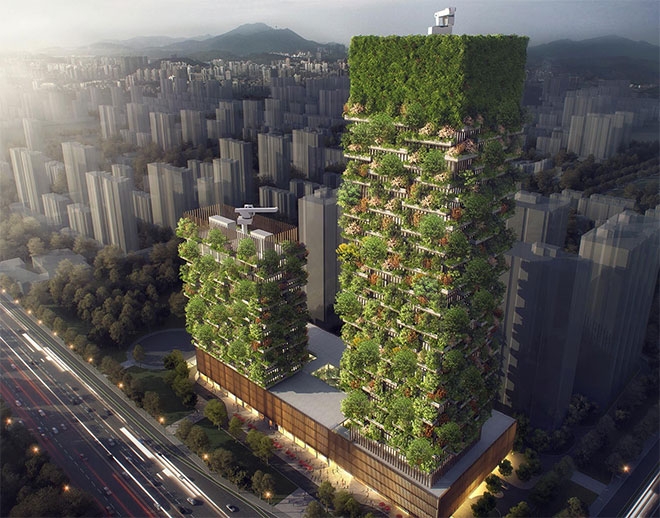Italian Architect and Urban Planner Stefano Boeri is bringing the construction of the “Nanjing Towers” to Pukou District in the city’s northern suburb; two towers that will house 730 trees, 5,000 shrubs and 11,000 plants.
In addition to their air filtering effects and luscious look, after two years they will also attract over 20 species of birds likely to take up residence in the towers.
Nanjing Vertical Forest is a pair of tower buildings, located in the Mingfa Fortune Plaza of Nanjing Pukou District. The project aims to export the green concept of the Vertical Forest in Milan to China, and to reflect Vertical Forest development, which incorporates greenery on the façades extending the full height of the buildings.
The project is the first Vertical Forest in China, applied through research and practice into Nanjing’s local climate, landscape, vegetation, site conditions and other aspects which, combined with each other, bring real building innovation and urban biodiversity to China.
Said to produce around 132 pounds of oxygen every day, the pair of buildings shall tower above at 656 feet and 354 feet tall as the first biodiversity project of its kind to go ahead in Asia.
Writing for inhabit.com Lacy Cooke noted, “Nanjing Yangzi State-Owned Investment Group Company Limited is promoting the towers and is listed by Stefano Boeri Architetti as an investor in the project”.
The Pukou based State Owned company prides itself on its green credentials with an office headquarters that not only sustain themselves via solar panels on the roof, but also pump additional electricity back into the local grid.
“The taller tower will hold offices, a museum, a green architecture school, and a rooftop club. The second tower will host a 247-room Hyatt hotel and rooftop swimming pool. A podium 65 feet high will include shops, restaurants, and a conference hall. Balconies on the buildings will allow inhabitants to get up close to the nature thriving on the building facades”, Cooke went on to say.
Critics are focusing on other aspects of the design which cause concern for long-term sustainability. “When discussing sustainability, one has to look at the whole picture. Trees, and the soil they need to survive and grow, are heavy and it takes a lot of reinforced concrete to support them on these cantilevered balconies. Concrete is responsible for 5 to 7 percent of the carbon dioxide we produce, so the responsible and sustainable thing is to use less of it. Without an analysis of how much concrete is needed to support these trees, vs how much CO2 the trees absorb, you can’t call this sustainable design”, stated Lloyed Alter of Treehugger.com.
This project nevertheless remains a commendable ambition to try and steer our Nanjing and China toward a greener more biodiversible future. Time will certainly tell, with the Nanjing Towers ambitiously slated for completion in 2018.









